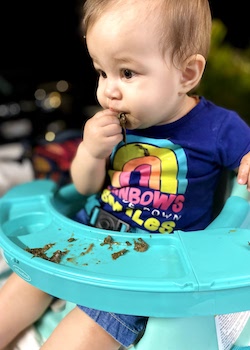
Scant data is available about the dietary habits of expectant and new mothers and their infants in the Native Hawaiian community. When many different populations and cultures are lumped together by surveys and the census into the “other” category, it is impossible to tease out anything of value.
That’s why the University of Hawaiʻi Mānoa Department of Human Nutrition, Food, and Animal Sciences in the College of Tropical Agriculture and Human Resources, in collaboration with the John A. Burns School of Medicine (JABSOM), UH Cancer Center and Purdue University, are conducting the study “Exploring Diet Diversity of Native Hawaiian Infants.”
“There isn’t enough information about how Native Hawaiian babies are eating and growing,” said Marie Kainoa Fialkowski Revilla, UH Mānoa associate professor in human nutrition and principal investigator. “Through promoting healthy and thriving babies, new mommies and families, we are hopeful that improved outcomes would follow. This study will make a meaningful impact on the Native Hawaiian community.”
Collecting data, photos on app

Expectant mothers must be Native Hawaiian, 18 years and over and have a smartphone to download the study’s app. Baby’s vitals are recorded from birth, and mothers complete a survey when their baby is two months old. Then when their baby reaches their 4th, 6th, 9th, and 12th months, mothers will use the app to take photos of their meals and their baby’s meals for three days. No baby pictures and no selfies are required. “Anyone with decent Instagram skills can do this,” said Revilla. “Don’t we all take pictures of our food?”
Bliss Kaneshiro, a professor in the JABSOM OB-GYN Department, is assisting Revilla. Kaneshiro said, “I love being a part of Dr. Revilla’s study because it’s so easy for patients to participate. I think parents, children and families will really benefit from the results of this study. Studies done in other parts of the country just don’t apply here in Hawaiʻi because of our racial diversity, which plays a role in the food we eat and the food we provide to our babies.”
The National Institutes of Health has funded the project through JABSOM and Ola HAWAII. Revilla and Kaneshiro are eager to collect the data that can make a difference in daily health and wellness choices made by those in the Native Hawaiian community.
“The study is designed to promote healthy thriving babies, new mothers and families. Attention to diversity is underway and the data should be reflective of diverse populations,” Revilla said. “Data has to be collected in such a way that is appropriate and it must make an impact on the Native Hawaiian population.”
For more information about the study, contact Revilla at (808) 753-3441.
This research is an example of UH Mānoa’s goal of Excellence in Research: Advancing the Research and Creative Work Enterprise (PDF), one of four goals identified in the 2015–25 Strategic Plan (PDF), updated in December 2020.

